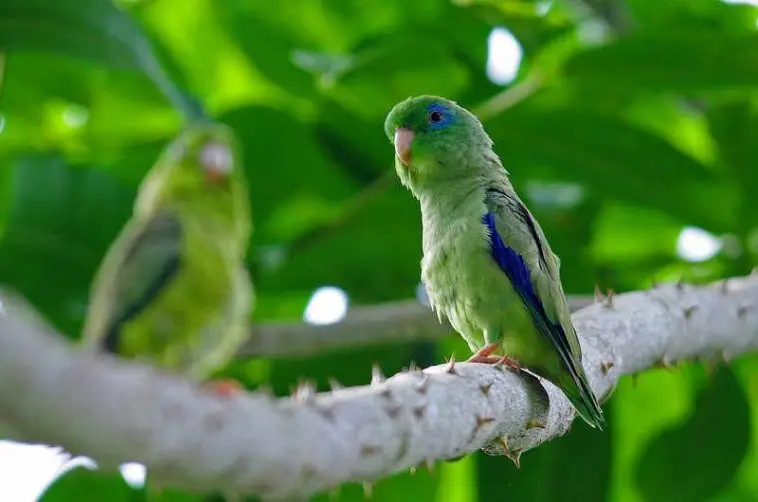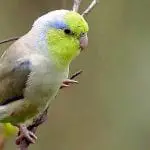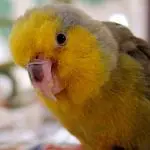Scientific Facts
| Common Name: | Spectacled Parrotlet |
| Scientific Name: | Forpus Conspicillatus |
| Life Span: | 20 to 25 years |
| Size: | 12 centimeters in length |
| Habitat: | Humid lowland forests and tropical dry forests |
| Country of Origin: | Middle and South America, including central and northern Colombia, eastern Panama, and Venezuela |
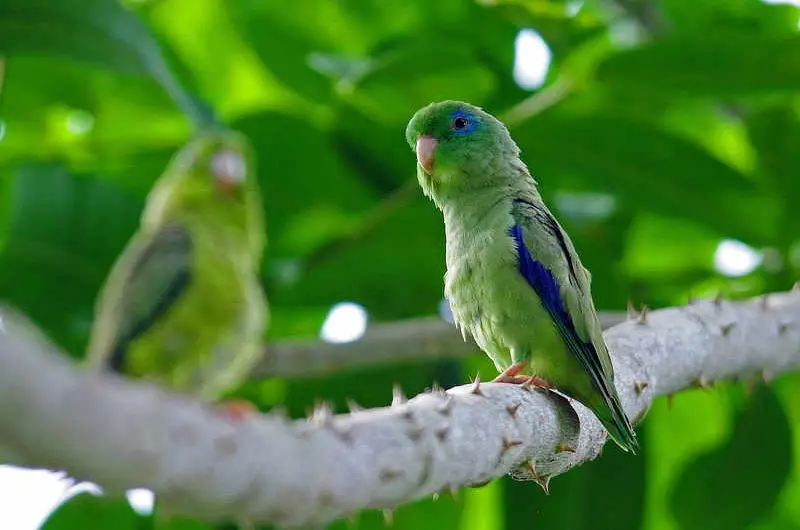
Physical Description
Spectacled Parrotlets suit the famous variety of pocket parrots. Adult Spectacled Parrotlets have an average length of 12 centimeters and weigh 30 grams. These creatures do not have plenty of specifics in their plumage; however, that does not stop them from displaying a very cute appearance. Their body is mainly hued with green with rose-colored feet and beak. The unique specifics are the light blue circles surrounding the eyes and tips of tail feathers and on the wing. The belly is a bit paler green when compared to the rest of the body parts.
Male Spectacled Parrotlets are noticed to have a yellowish-green forehead which stretches to their cheeks and throats. Their underparts are a bit paler in coloration, with a spread of bluish-gray in the breast. They have dark green wings and upper back. The rump and lower back are violet-blue, with a darker tone in the rump. Their primary and secondary coverts are also in violet-blue, so are the carpal edge, underwing coverts, and axillaries. The lower portion of the flight feathers is bluish-green. Their irises are brown. Young cocks do not have the blue circle surrounding the eye. Rather, this portion is emerald-green.
Female Spectacled Parrotlets, on the other hand, are paler when it comes to the general coloration, with the blue sections of the male parrotlets being green. They have brighter upperparts, with the portion around the eye in emerald-green. Their underparts are more toned. Young females look similar to adults.
Lifespan
Spectacled Parrotlets have a lifespan of 20 to 25 years. If given with proper attention and a healthy diet, these creatures are expected to live and reach this period. Nevertheless, it is observed that the average life expectancy based on the breeding, inbreeding bloodlines, diet plan, and diet is more around 10 to 20 years. Needless to say, the lives of these creatures are determined by their environment and the kind of foods they are eating. Owners should dedicate themselves to effectively raise these birds.
In the U.S., the lifespan seems to be getting shorter due to the inbreeding, which has occurred over the past 20 years as an output of not having to import any bloodlines or brand-new birds in the nation.
Eating Habits
In the wild, Spectacled Parrotlets feed on leaves, nuts, cactus, berried, seeds, and other kinds of fruits. There are times that they also eat small insects. You will also observe these creatures, either eating or licking clay. The licking of clay gives these birds a great source of minerals like calcium.
On the other hand, the feeding frequency, as well as the volume of food given to hand-fed birds, reduces as they develop.
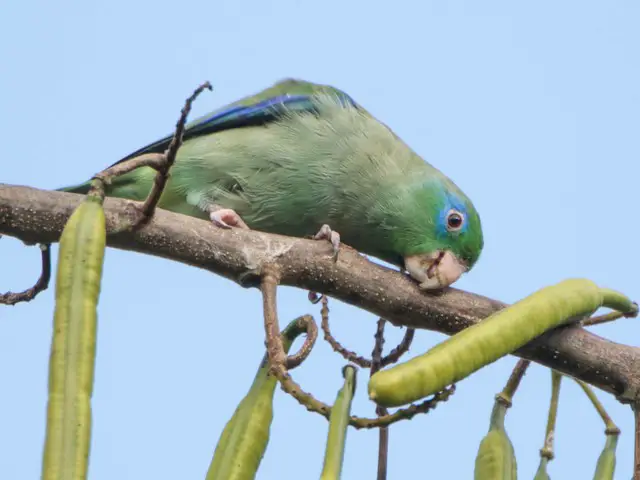
Sleeping Habits
Spectacled Parrotlets are very reactive to light. They easily fall asleep when the surrounding is dark and easily gets awake if there is light. Covering the cage shall give the owners more control over this situation.
Sleep is an effective way to supervise the health of your pet. These creatures should have at least 9 to 12 hours of sleep per day. These birds will normally do beak grinding while they get to sleep. This is where you notice them rubbing the two snouts of their beak together, creating a mild sound nearly similar to teeth grinding. Novices are often worried about this; however, this is a healthy indication. Pets will normally do the beak grinding if they feel relaxed and contented, which is the reason they happen to portray it before snoozing.
Development and Reproduction
The parents earnestly reconstructed their family by supervising the second and consequent fledglings, which were abandoning the nest in 1 to 2 days interval into a tree where their formerly fledged nestmates were lingering. Many nearby breeding pairs gathered their offspring in a similar tree and created a nursery there. They divested their freshly fledged offspring of associative interactions starting from the first day after fledging and beyond. The parents dwelled in the proximity of the nursery locality for a limited period only. Often, they were out, primarily for foraging hustles. Once they return, they solely fed their chicks. In the night-time, the pairs supervised their offspring into dense and high inhabiting trees, and every morning the nursery was recalled.
Fledglings go through four formative stages. First, a limited period of firm associative connections with the parents. Second, a stage of synergies with their siblings and also with unconnected young parrotlets of roughly similar age in a static nursery. Third, a motile nursery period in which the entire members of the nursery burrowed the environment of the nursery tree. And fourth, a stage in which the nurseries create firm sibling relationships and ultimately become non-dependent from their parents.
Socialization in nurseries and enduring sibling relationships can be the result of promptly parent-offspring strife, which is concluded generally by the parents. It allows the parents to brace themselves for the following breeding period by curtailing the period they allocate with the juvenile, which, however, are given with superior settings for socialization.
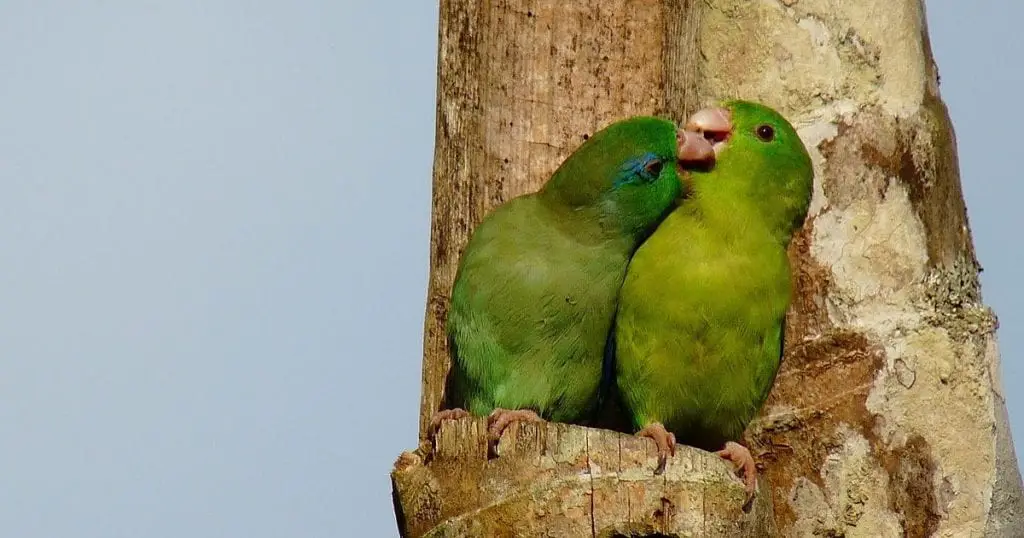
How to Breed
Determining the Sexes
Spectacled Parrotlets are sexually dimorphic. This implies that male and female parrotlets can be determined by simply checking their physical appearance. There is a distinction between the looks of a male and female Spectacled Parrotlet. The forehead of the male parrotlets is yellowish-green, and it extends to the cheeks and throats. The underpart of male parrotlets is a bit paler, while females have more toned coloration.
Courtship and Mating
Spectacled Parrotlets live in a complicated structure of individual relationships all through their lives. Adults establish restricted pair bonds, undertaking all amiable and sexual behavior sequences to each other. The pair mates collaborate in combative situations. Provided that they keep close together, they carry similar rank-order position.
In mate-choice tests, females essentially opt a mate that formerly adhered to an influential social position. Non-exclusive bonds can also be noticed among these creatures. These are far less permanent than the exclusive ones. Only the exclusive pairs get a promising opportunity to inhabit a breeding cavity.
Eggs and Incubation
Once a female Spectacled Parrotlet lays one egg, another egg shall be laid every after two days until the size of the clutch is reached. Commonly, a couple shall hatch 4 to 6 eggs every clutch after an incubation period of 18 days.
Babies fledge at around 5 weeks old. Siblings are still in close relationship within a few weeks of post-fledging.
Common Health Problems
Hyperthermia and Dehydration
Spectacled Parrotlets cannot indulge in excessive heat. A bird that is overheated may quickly develop hyperthermia and may die. Once exposed to overheating, the bird shall manifest panting. This act of panting shall also lead to dehydration. Many birds that are experiencing hyperthermia will attempt to escape the heat and may attempt to bathe to settle down, if possible.
Infections
Infections may circulate on baby birds. A lot of diseases are seen harmful to babies, particularly the polyomavirus. Adult parrotlets are also exposed to other parrotlets from similar sources.
Toxins
Several foods are considered toxic to Spectacled Parrotlets. Chocolates are harmful to your pet because they are digested differently. Other foods that are harmful to these birds are caffeine, avocados, and onions.
Also, there are plenty of common household cleaning chemicals and disinfectants that release fumes that can be toxic to these birds. Ammonia, phenols, and chlorine bleach contain hazardous vapors, which may lead to toxicosis, irritation, or even death.
Respiratory Diseases, Skin Irritation, and Chronic Eye Problems
Static inhalation of a cigar, cigarettes, and pipe smoke may lead to respiratory diseases, skin irritation, and chronic eye problems. Spectacled Parrotlets that are placed in homes exposed to smokes may develop sneezing, coughing, conjunctivitis, and sinusitis, which may conclude instinctively if the pet is transferred to a site that is free from smoke. Some Spectacled Parrotlets that are threatened to chronic second-hand smoke shall form secondary bacterial defilements too, which can be lethal.
Typical household aerosol products like hairspray, deodorant, and perfume can also trigger respiratory issues in birds. They may trigger difficulty in breathing and severe inflammation, and after a huge or immediate exposure, the bird may die. Any aerosol or pump spray that uses a propellant may be harmful to your pet bird, and these must not be applied when the birds.
Gas leaks may also lead to the sudden death of these birds. Carbon monoxide, a colorless, odorless, and tasteless gas, may be harmful to the birds. Second-hand smoke coming from marijuana may also trigger regurgitation and severe depression. Overheated cooking oils, burning foods, and smoke coming from a fire may lead to fatal inhalations.
Preventing Illnesses
Being a responsible owner, your main objective should be to keep your pet healthy. The last thing you would want your pet to experience is to get ill. To prevent illnesses, make sure that you comply with the requirements of maintaining a pet. Knowing that its environment is vital for Spectacled Parrotlets, you have to make sure that you provide them an ideal and clean cage. Remember that these creatures need a roomy cage so they can conveniently move around. Another thing to consider in keeping your pets healthy is to provide them the best and balanced diet. You should also know what foods are not to be served to these birds to avoid risks in health.
Behavior
Spectacled Parrotlets are tiny creatures. For so many reasons, these birds are ideal for pets. They are giddy, social tiny parrots, and possess plenty of admirable characteristics that make them famous in the world of aviculture. They are smart and inquisitive. These birds do not create too much noise, which is the main reason why novices are inclined to adopting them. Many beginners cannot adjust to noisier birds. With their typical natural calls that are represented by cartoonish chirps and tweets, there is nothing else significant to worry about.
These birds are relatively intelligent and will rapidly learn to perform some basic tricks. Owners will easily fall in love with these birds seeing their giddy little walk with their tiny feet moving with goofy speed. They are affectionate pets and are known for caressing and hollowing out underneath the blankets to look for scratches. Else ways, these birds also have their playful and silly sides, which can be at times wander into trouble. All these are merely simple and inoffensive fun, though. These birds do not sing; however, they may replicate the voice of a human. Although they can be characterized as friendly creatures, they are also known to be very fierce.
They can be trained to talk and apportion the attitude of a lovebird. They may get chilly and need training. They have figured out their beaks as their method of disciplining once they are over with the “baby stage.” They can be fairly naughty. These birds can also be taught to whistle. They are not as headstrong as other parrotlets; however, they are spirited, fearless, and extroverted, and you have to create strong yet gentle supervision to prevent these birds from trying to govern the household.
All members of the group are integrated with a lot of their activities like resting, preening, or foraging. These birds are intently engrossed in bizarre activities of other members. Social grasping, involving the imitation of sexual techniques, happens to be important. Spectacled Parrotlets utilize contact calls to attribute to a social comrade and hence are designating or identifying their conspecifics. They may thus have intellectual portrayals of their social comrades, a significant aptitude to reside within their complicated social pattern.
Habitat
Cage
Spectacled Parrotlets should be housed in a cage that is made from powder-coated metal. The dimension should be at least 24 x 18 x 24 inches, and the bar spacing should be half an inch. Place an assortment of perches from different bird-safe woods. Bear in mind that although they are small in size, they have a characteristic of being territorial. You have to establish a play area far from the cage where you can take out the bird daily. This should give you the convenience of playing with your bird on neutral territory. Teach your pet to step up on instruction on a stick or perch so you can conveniently take it out from the cage without bickering.
Toys
Toys are important for these birds because they give them entertainment. However, some owners have said that toys such as mirrors and bells in the cage can influence the bird to become mad or assertive. Hence, cautiously examine for that if you decide to give those toys.
Diet
A high-quality commercial seed mix formulated for parrotlets has an assortment of white millets, oats, sunflower seeds, and comparable goodies that your bird will relish. A random light meal composed of fresh vegetables and fruits is necessary. These creatures also love cooked rice, berries, cabbage, carrots, and fresh salad. Raspberries will also make a definite treat for these birds. Pellets are commonly the chosen diet because of their abundant nutrition. Pellet diets are commonly rich in minerals and proteins. Calcium is obtained from this kind of diet. Calcium is important because it guarantees the bird is receiving the essential minerals that it will naturally get from its diet in the natural habitat.
It is also important that you provide your pet a clean and freshwater. This is vital to your pet. Depriving your pet with water may lead to harmful results.
How to Care for Spectacled Parrotlet
Knowing that they are small creatures, owners will have to dedicate more attention to prevent the occurrence of accidents around their homes. You should always be aware of their whereabouts so that you will not fortuitously crush or step on them when they are playing. There are times that these birds become naughty. Hence, it is very important to comprehend their behaviors and to supervise their actions before a troublesome behavior is developed. Even an immature bird that has not been ignored and harmed needs appropriate guidance. This is, even more, confronting when it includes a rescued bird that may need rehabilitation. Splashing them with a mister bottle will work in diminishing any negative habits. Nevertheless, constant guidance is necessary. A well-mingled and properly managed Spectacled Parrotlet is a dazzling and affectionate bird that is not a bit apprehensive and is glad to demonstrate wacky behaviors. To keep the quality of your pet, it would be better to keep a single Spectacled Parrotlet and concentrate your unswerving concentration on that bird. If you consider getting two Spectacled Parrotlets, you should know that they are likely to become intensely entangled with one another, and your bird may lose its meekness.
Your pet is not aware of its size; hence, you should gently handle it, yet considerably decisively, to inhibit them from choosing to stay inside the cage and act as a dictator of their little domain. You can also stop your pet from active aggressive by giving it enough attention and by keeping its wings tidily clipped.
Where to Get One?
Spectacled Parrotlets would make ideal pets at home. If you are thinking of getting one, make sure that to assess yourself whether this bird is meant for you. Aside from your interest in raising this bird, you should be certain that you can provide your soon-to-be pet the necessary care and nourishment. You should be a responsible owner.
These pets are available in many pet stores. Many bird breeders are also selling these creatures. To say, you have wide options on where to get these birds. However, you should be cautious when finally choosing for your pet. Although there are plenty of sellers out there, they do not sell birds with the same health condition. Some can be sick, and this should mean that you cannot get a sickly pet. Make sure that you only buy a bird in perfect health condition.
FAQs
Is it important to cover the cage of my Spectacled Parrotlet during sleep time?
A lot of people opt to cover the cage of their pets during night-time. Although it is not fundamental, it can be beneficial to your pet. Covering the cage will help your bird less likely to be awakened at the breach of dawn. Moreover, covering the cage may also lessen night frights.
Why is my Spectacled Parrotlet biting me?
There is no definite explanation for this question. Same with people, Spectacled Parrotlets have their characteristics, and you cannot just manage each one similarly. However, you should know that the stage of biting is normal within a period of 6 months to 1 year. Your pet has a special affection for men. The biting may not mean that your pet does not adore you anymore.
Is it necessary to clip the wings of my Spectacled Parrotlet?
There are numerous justifications why many bird owners decide to clip the wings of their birds. Although wing clipping is overall suggested for many captive bird pets, the judgment to proceed with the trimming is best given to the owner.
Other than guaranteeing that their pet will not accidentally breakaway, the ultimate reason why many owners clip the wings of their birds is for safety purposes. Life indoor demonstrates dangers that these creatures do not commonly encounter in the wild, such as ovens, ceiling fans, windows, toilets, sinks, and doorways. By clipping the wings of the bird, their accesses to danger zones are being restricted.
Another explanation of clipping the wings is that it compels the bird to become reliant on the owner. A lot of owners perceive that it can act to improve the bond between the bird and human.
Will, my relationship with my Spectacled Parrotlet, gets affected if I get another one as its mate?
It all depends on you. If you get another parrotlet but still allocate plenty of time for them, feeding them, holding them, playing with them, and talking with them, then there is no reason for your Spectacled Parrotlet to get distant from you. Do not let your pet feel ignored by you because there is a possibility that it will divert its full attention to its mate.

